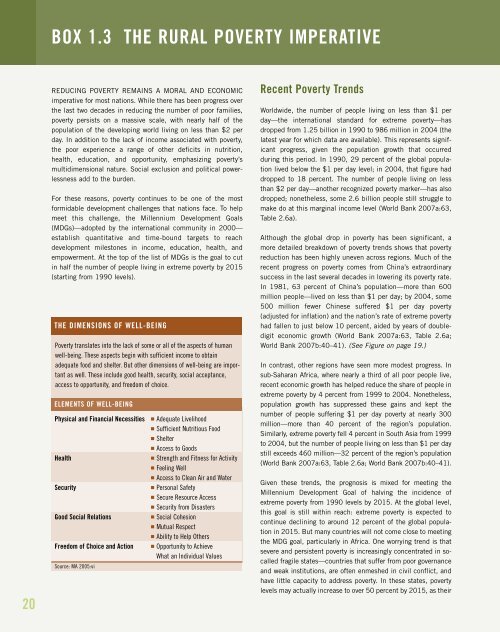Growing the Wealth of the Poor - World Resources Institute
Growing the Wealth of the Poor - World Resources Institute
Growing the Wealth of the Poor - World Resources Institute
Create successful ePaper yourself
Turn your PDF publications into a flip-book with our unique Google optimized e-Paper software.
BOX 1.3 THE RURAL POVERTY IMPERATIVE20REDUCING POVERTY REMAINS A MORAL AND ECONOMICimperative for most nations. While <strong>the</strong>re has been progress over<strong>the</strong> last two decades in reducing <strong>the</strong> number <strong>of</strong> poor families,poverty persists on a massive scale, with nearly half <strong>of</strong> <strong>the</strong>population <strong>of</strong> <strong>the</strong> developing world living on less than $2 perday. In addition to <strong>the</strong> lack <strong>of</strong> income associated with poverty,<strong>the</strong> poor experience a range <strong>of</strong> o<strong>the</strong>r deficits in nutrition,health, education, and opportunity, emphasizing poverty’smultidimensional nature. Social exclusion and political powerlessnessadd to <strong>the</strong> burden.For <strong>the</strong>se reasons, poverty continues to be one <strong>of</strong> <strong>the</strong> mostformidable development challenges that nations face. To helpmeet this challenge, <strong>the</strong> Millennium Development Goals(MDGs)—adopted by <strong>the</strong> international community in 2000—establish quantitative and time-bound targets to reachdevelopment milestones in income, education, health, andempowerment. At <strong>the</strong> top <strong>of</strong> <strong>the</strong> list <strong>of</strong> MDGs is <strong>the</strong> goal to cutin half <strong>the</strong> number <strong>of</strong> people living in extreme poverty by 2015(starting from 1990 levels).THE DIMENSIONS OF WELL-BEINGPoverty translates into <strong>the</strong> lack <strong>of</strong> some or all <strong>of</strong> <strong>the</strong> aspects <strong>of</strong> humanwell-being. These aspects begin with sufficient income to obtainadequate food and shelter. But o<strong>the</strong>r dimensions <strong>of</strong> well-being are importantas well. These include good health, security, social acceptance,access to opportunity, and freedom <strong>of</strong> choice.ELEMENTS OF WELL-BEINGPhysical and Financial NecessitiesHealthSecurityGood Social RelationsFreedom <strong>of</strong> Choice and ActionSource: MA 2005:vi■ Adequate Livelihood■ Sufficient Nutritious Food■ Shelter■ Access to Goods■ Strength and Fitness for Activity■ Feeling Well■ Access to Clean Air and Water■ Personal Safety■ Secure Resource Access■ Security from Disasters■ Social Cohesion■ Mutual Respect■ Ability to Help O<strong>the</strong>rs■ Opportunity to AchieveWhat an Individual ValuesRecent Poverty Trends<strong>World</strong>wide, <strong>the</strong> number <strong>of</strong> people living on less than $1 perday—<strong>the</strong> international standard for extreme poverty—hasdropped from 1.25 billion in 1990 to 986 million in 2004 (<strong>the</strong>latest year for which data are available). This represents significantprogress, given <strong>the</strong> population growth that occurredduring this period. In 1990, 29 percent <strong>of</strong> <strong>the</strong> global populationlived below <strong>the</strong> $1 per day level; in 2004, that figure haddropped to 18 percent. The number <strong>of</strong> people living on lessthan $2 per day—ano<strong>the</strong>r recognized poverty marker—has alsodropped; none<strong>the</strong>less, some 2.6 billion people still struggle tomake do at this marginal income level (<strong>World</strong> Bank 2007a:63,Table 2.6a).Although <strong>the</strong> global drop in poverty has been significant, amore detailed breakdown <strong>of</strong> poverty trends shows that povertyreduction has been highly uneven across regions. Much <strong>of</strong> <strong>the</strong>recent progress on poverty comes from China’s extraordinarysuccess in <strong>the</strong> last several decades in lowering its poverty rate.In 1981, 63 percent <strong>of</strong> China’s population—more than 600million people—lived on less than $1 per day; by 2004, some500 million fewer Chinese suffered $1 per day poverty(adjusted for inflation) and <strong>the</strong> nation’s rate <strong>of</strong> extreme povertyhad fallen to just below 10 percent, aided by years <strong>of</strong> doubledigiteconomic growth (<strong>World</strong> Bank 2007a:63, Table 2.6a;<strong>World</strong> Bank 2007b:40–41). (See Figure on page 19.)In contrast, o<strong>the</strong>r regions have seen more modest progress. Insub-Saharan Africa, where nearly a third <strong>of</strong> all poor people live,recent economic growth has helped reduce <strong>the</strong> share <strong>of</strong> people inextreme poverty by 4 percent from 1999 to 2004. None<strong>the</strong>less,population growth has suppressed <strong>the</strong>se gains and kept <strong>the</strong>number <strong>of</strong> people suffering $1 per day poverty at nearly 300million—more than 40 percent <strong>of</strong> <strong>the</strong> region’s population.Similarly, extreme poverty fell 4 percent in South Asia from 1999to 2004, but <strong>the</strong> number <strong>of</strong> people living on less than $1 per daystill exceeds 460 million—32 percent <strong>of</strong> <strong>the</strong> region’s population(<strong>World</strong> Bank 2007a:63, Table 2.6a; <strong>World</strong> Bank 2007b:40–41).Given <strong>the</strong>se trends, <strong>the</strong> prognosis is mixed for meeting <strong>the</strong>Millennium Development Goal <strong>of</strong> halving <strong>the</strong> incidence <strong>of</strong>extreme poverty from 1990 levels by 2015. At <strong>the</strong> global level,this goal is still within reach: extreme poverty is expected tocontinue declining to around 12 percent <strong>of</strong> <strong>the</strong> global populationin 2015. But many countries will not come close to meeting<strong>the</strong> MDG goal, particularly in Africa. One worrying trend is thatsevere and persistent poverty is increasingly concentrated in socalledfragile states—countries that suffer from poor governanceand weak institutions, are <strong>of</strong>ten enmeshed in civil conflict, andhave little capacity to address poverty. In <strong>the</strong>se states, povertylevels may actually increase to over 50 percent by 2015, as <strong>the</strong>ir
















